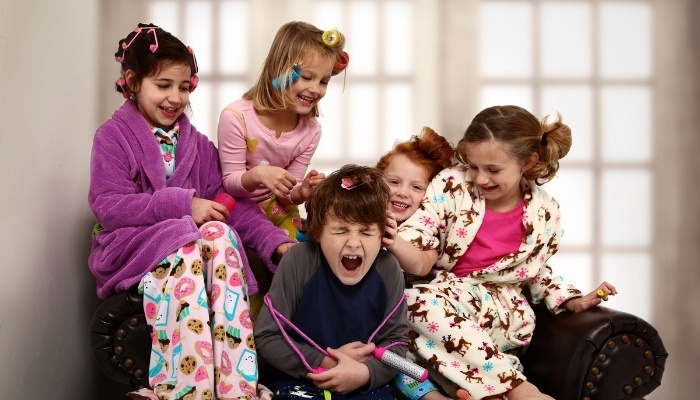As your child begins attending school, they will begin to form friendships which may eventually lead to receiving invitations for sleepovers.
What is the appropriate age for sleepovers? According to some experts, children are ready for their first sleepover between the ages of 7 and 9 years old; however, every child is unique. Consider your child’s maturity and independence, where and with whom the sleepover will be held, and the potential risks involved at other families’ homes.
Read on to learn more about why this age makes the most sense, along with other important information to consider before making your decision.
Is My Child Ready for a Sleepover? Factors To Consider
Every child is different, so it’s important to examine some key considerations before allowing them to spend the night away from their own bed.
1. Child’s Independence & Maturity
Does your child understand right from wrong? This, of course, can differ between families. The parents of your child’s friend may think it’s acceptable for kids to watch some higher-rated movies; you may have a different viewpoint.
Your child should understand the rules and values of your home and keep them consistent wherever they go.
2. Sleepover With Grandparents or Other Family
This is a great test run. We have some recommendations for your child staying overnight with relatives:
- Make sure they’re feeling well and not overtired. Being at their peak will help them more easily adapt to new situations.
- Parents and grandparents / other family have to agree on things like what’s acceptable for dinner, bedtime, entertainment, etc.
- Any comforts from home should come along. This means things like stuffed animals, favorite jammies, etc.
- Make sure their sleeping area is comfortable for them to sleep in. If the grandparents’ house has a barebones guestroom, this may not be ideal. Make it warm and inviting.
- Double-check that your child has everything they need. This includes the toothbrush and flavor of toothpaste they’re used to, brushes for their hair, etc.
3. Sleepover at Your House
A great way to test if your child is ready for a sleepover is to host first. Start with one child and see how things progress. Do they get along? How do they act when they’re both tired?
With everything at your house, you’ll have more control and thus be more comfortable.
4. Sleepover at Friend’s House
While this may seem to be the next natural step for sleepovers, there are some considerations before giving your approval.
You definitely want to meet the parents first if you don’t know them already. Be sure that you’re child will not be exposed to anything that goes against the values you are trying to instill.
Don’t be shy about asking questions. Ask who will be present in the home, what the planned activities are, how much supervision there will be, and anything else that concerns you.
You can also give your child a “sleepover phone” that isn’t meant to be their permanent smart device — just a way to always stay connected. All you need is something cheap that works.
And finally, make sure your son or daughter knows there’s always an out if they wish to come home at any time, day or night.
5. Dangers of Sleepovers
You may be worried about the potential risks of sleepovers. Some parents fear these events leading to behavioral problems or even exposure to abuse, and unfortunately, these concerns are valid.
Parents of teenagers fret their kids will make bad choices when surrounded by peers in the late hours of the night, and parents of younger children have even more potential issues for which to be concerned.
Beth Robinson, a licensed professional counselor and author of Protecting Your Children From Predators, suggests parents consider five risk factors before allowing a sleepover.
“Children are most often abused in familiar places, not in strange places. This makes the home of a friend a potential risk.
Children are most often abused by trusted people, typically by males. Sleepovers tend to happen in the homes of trusted people where males are present.
Children tend to be safest in small crowds, where it is difficult to separate one from the others. A highly attended sleepover presents a larger risk because children can easily be separated with their absence unnoticed.
Households often have visitors staying in them as well as the “normal” family members. Unexpected guests could be a risk.
Sleepovers often allow children access to various media where few safeguards are in place.”
That’s why it’s so important to have important conversations with the hosting parents.
However, psychologist and author of the book Resilience Builder Program for Children and Adolescents Mary Alvord says these risk factors shouldn’t lead to parents banning sleepovers altogether.
Alvord says these social activities help kids move toward independence, thus avoiding developing things like separation anxiety.
It also helps them learn what’s known as “cognitive mental flexibility” — kids will inevitably experience things at a friend’s home that are different from what they know.
Ultimately, it’s your choice. Just be aware of what can go wrong, be sure your child understands right from wrong, and be certain that they can contact you at any time.

What Age Do Most Kids Have Their First Sleepover?
An online survey revealed many parents are okay with their children engaging in sleepovers between the ages 6 and 8 years old. However, you need to make the decision for yourself based on the criteria we have covered.
As we started before, some experts say between the ages of 7 and 9 years old is ideal, which is close to what the surveyed parents feel.
How To Prepare Your Child for Their First Sleepover
Typically, first sleepovers occur at the home of grandparents or other nearby close family. This offers several advantages. Your child is already familiar with the surroundings and has a relationship with the caregiver, and family typically knows and respects your wishes.
If your child is already comfortable with sleeping over at a family member’s house or if this isn’t an option, the next step is usually hosting a sleepover at your house. It’s best to limit this time to just one guest to avoid anyone getting left out or there being “too much of a good thing.”
Before any sleepover, establish rules for behavior and bedtime. When it’s time to take the next step and have a sleepover at a friend’s house, have a special talk with your child first.
- Explain the importance of being respectful and obedient while away from home.
- Stress the fact that they can call you anytime and for any reason.
- Be sure they understand what inappropriate behavior and abuse are and know they can talk to you about anything.
- Listen to any concerns they may have, and offer solutions for each.
- Allow them to pack one or two comfort items.
- Share stories of your experiences with slumber parties as a child.
- Tell your child that you are proud of them, and emphasize that this is a big step in their lives. This will give them a boost of confidence and may encourage them to be on their best behavior.
When the big day arrives, be sure to enter the friend’s house with your child to get a feel of things and be sure he or she is properly introduced to everyone and is polite.
Don’t be too surprised if your child calls later on either wanting to say goodnight or to be picked up. This is completely normal.
As time goes on, their confidence will grow, and they’ll soon be sleepover pros, so enjoy this last little bit of clinginess before it vanishes entirely, and don’t feel guilty about enjoying a bit of time for yourself!
Sleepovers at Your House – Setting Ground Rules
You want to be sure everyone knows what’s expected.
This includes what is and is not allowed, what they can and cannot eat/drink, and what they can and cannot bring to the party. Above all, make sure everyone understands that safety comes first!
Make sure that not only do all the kids understand these rules — but their parents do too. You don’t want them allowing their child to bring something over (like a violent video game, for example) you don’t approve of.
Don’t leave the kids to their own devices all night. Check on the group regularly to make sure that everyone is having fun and following the rules.
Tip: Check in periodically with a tray full of fun snacks so that you don’t appear too nosy or overprotective.
How To Say No to Sleepover Requests
If you’re NOT okay with your child sleeping over at someone’s house, then here are some important tips.
- Make sure you are kind in turning down the invitation. Be grateful that they wanted to include your child.
- Don’t allow the fear of hurting someone’s feelings slow down your response, as that could make the other person impatient or begin planning for something that ultimately won’t happen.
- Be honest. This way there’s no misunderstanding that can cause friction or other complications later.
What Time Should a Sleepover Start and End?
A solid suggestion for start and end times comes from Parenting.com. They state guests should arrive no earlier than 5:00 p.m. Make sure parents know what’s for dinner so picky or allergy-prone guests have fair warning.
Another option is 7:00 or 8:00 p.m. so that the pajama-wearing and snack-indulging can start right away.
As for pick-up time, go with around 11:00 A.M. It’s not too early, but you’re not required to continue hosting/entertaining too long past breakfast.
Fun Activities for Sleepovers
Sleepover activities all depend on the ages of the kids staying over. Some fun ideas we found are:
- Craft projects
- Board games
- Outside play
- Karaoke
- Age-appropriate movies
- Campfire stories
- Talent show
- Baking
Conclusion
We hope reading this article has brought you some ideas and insight as it relates to your child asking for their first sleepover. Be sure to share it with friends as they may find it equally helpful!
As always, keep checking back regularly for more new content you can use!
Mom of three (including identical twin boys), wife, and owner of Parents Wonder. This is my place to share my journey as a mother and the helpful insights I learn along the way.

